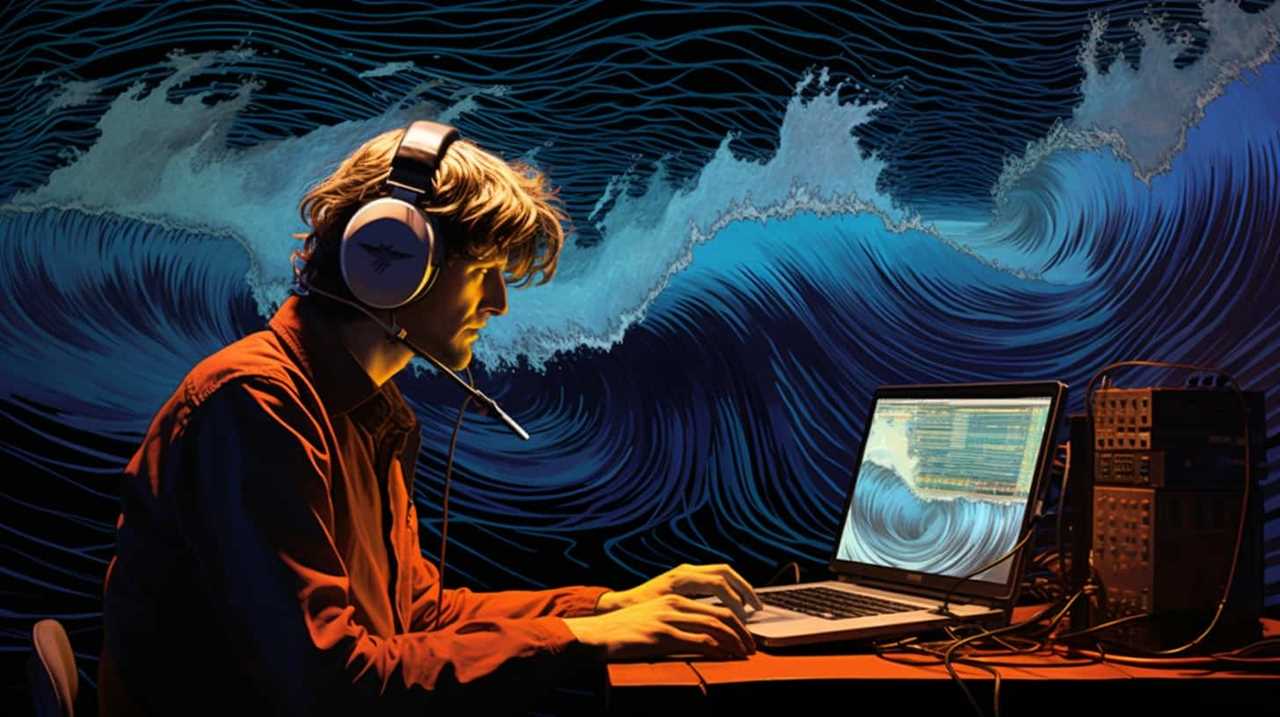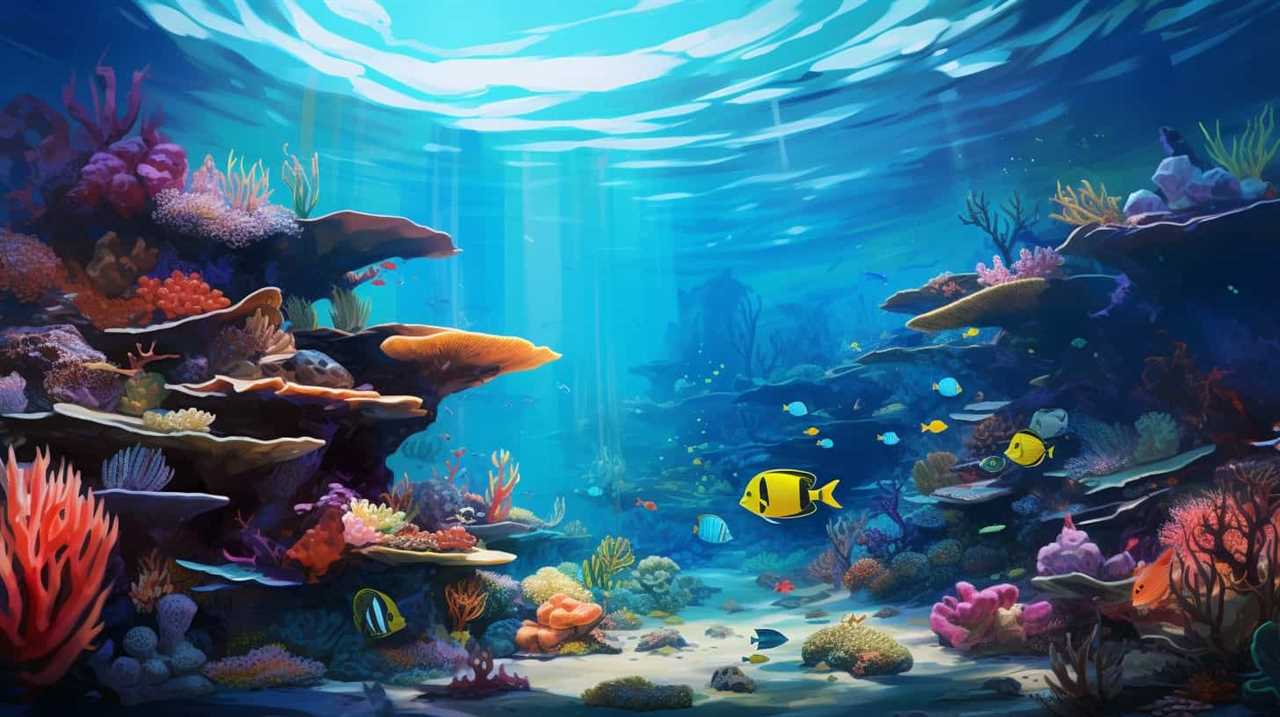Imagine yourself diving into the deep blue ocean, surrounded by a symphony of underwater sounds, a mystical world waiting to be explored.
In this article, we delve into the enigma of underwater sound analysis. We explore the techniques, tools, and challenges faced in deciphering the hidden messages of the deep.
Join us as we navigate the uncharted depths of underwater acoustics, seeking to uncover the secrets that lie beneath the waves.
Let us embark on this journey of discovery together.

Key Takeaways
- Hydrophone calibration is crucial for accurate underwater sound recording and analysis.
- Underwater sound analysis can provide insights into marine organism behavior and habitat.
- Overcoming challenges in underwater sound analysis is essential for unlocking the potential of underwater acoustics.
- Underwater acoustics has applications in marine conservation, navigation, communication, and various industries.
Sound Recording Techniques
We frequently use advanced sound recording techniques to capture underwater sounds and analyze them in our research. One of the main methods we employ is passive acoustic monitoring, which involves using hydrophones to passively record sounds in the underwater environment.
Hydrophones are specialized underwater microphones that are carefully calibrated to accurately capture and measure the acoustic signals. Hydrophone calibration is a critical step in ensuring the accuracy and reliability of the recorded data. It involves calibrating the hydrophones to known standards, such as sound pressure level and frequency response, to accurately quantify the recorded sounds.
This calibration process allows us to make precise measurements and comparisons between different recordings, enabling us to study various underwater sound phenomena with great accuracy and detail.
Underwater Noise Sources
Continuing our exploration into underwater sound analysis, we delve into the subtopic of underwater noise sources, examining the various sources of sound in the underwater environment. Understanding these sources is crucial as they contribute to underwater noise pollution, which can have a significant impact on marine life.

To provide a clear visual representation, let’s look at the table below, which outlines the primary sources of underwater noise and their potential impact on marine life:
| Noise Source | Impact on Marine Life |
|---|---|
| Shipping | Disrupts migration patterns |
| Oil and gas drilling | Causes stress and hearing damage |
| Underwater explosions | Results in injury and mortality |
| Sonar | Disorients marine mammals |
| Marine construction | Disturbs feeding and breeding behavior |
Tools for Analyzing Acoustic Data
To fully explore the depths of underwater sound analysis, we’ll now delve into the tools used for analyzing acoustic data. Understanding underwater sound propagation requires sophisticated equipment capable of capturing and interpreting complex sound waves.
One such tool is the hydrophone, a specialized microphone designed to detect and record underwater sounds. Hydrophones are strategically placed at various depths and locations to capture a wide range of acoustic data.
These data are then processed using advanced data interpretation techniques, including signal processing algorithms and spectral analysis.

By analyzing the frequency, amplitude, and temporal characteristics of the recorded sounds, researchers can gain valuable insights into underwater sound propagation and the behavior of marine organisms.
These tools are essential for unraveling the mysteries hidden in the vast depths of the underwater world.
Challenges in Underwater Sound Analysis
Our team encountered numerous challenges in underwater sound analysis due to the unpredictable nature of the marine environment. Conducting research in underwater acoustics requires expertise in understanding the complexities of underwater sound propagation and its impact on bioacoustics research. Here are some of the challenges we faced:
-
Ambient Noise: The marine environment is filled with natural and anthropogenic sources of noise, making it difficult to isolate and analyze specific sounds.

-
Signal Distortion: Underwater sound waves can be significantly affected by factors such as temperature, salinity, and underwater topography, leading to signal distortion and degradation.
-
Limited Accessibility: Accessing remote underwater locations for data collection and maintenance of equipment poses logistical challenges.
-
Data Interpretation: Analyzing and interpreting the collected data requires sophisticated algorithms and models due to the complex nature of underwater sound propagation.
Overcoming these challenges is crucial to unlocking the potential applications of underwater acoustics in various fields.

Transitioning into the next section, understanding the challenges allows us to explore the exciting applications of underwater acoustics.
Applications of Underwater Acoustics
After understanding the challenges in underwater sound analysis, we’ve discovered numerous applications for this field in various industries.
One significant application is in the study of marine mammal communication. By analyzing underwater sounds, researchers can gain insights into the complex communication systems of marine mammals such as whales, dolphins, and seals. This has profound implications for our understanding of these animals’ social structures, behavior, and ecological roles.
Additionally, underwater acoustics plays a crucial role in underwater navigation. By using sound waves to map the underwater environment and detect objects, it enables accurate positioning and navigation of submarines, autonomous underwater vehicles (AUVs), and other underwater systems. This has applications in fields such as marine exploration, offshore oil and gas, and underwater archaeology.

Frequently Asked Questions
How Does the Use of Sound Recording Techniques Contribute to the Understanding of Underwater Ecosystems?
The use of sound recording techniques enhances our understanding of underwater ecosystems by providing valuable data on underwater noise pollution and the impact of climate change on underwater sound.
What Are Some Common Sources of Underwater Noise That Can Interfere With Acoustic Data Analysis?
Underwater noise sources can interfere with data analysis. Common sources include ship traffic, seismic surveys, and marine construction. Understanding the impact of these noises is crucial for accurate acoustic data analysis in underwater ecosystems.
How Do Scientists Use Tools for Analyzing Acoustic Data to Study Marine Mammal Populations?
We analyze acoustic data to study marine mammal populations by using tools that allow us to track their behavior and assess the impact of underwater noise pollution on their habitats.
What Are Some of the Major Challenges Faced by Researchers in the Field of Underwater Sound Analysis?
In underwater sound analysis, researchers face numerous challenges. These challenges include identifying and differentiating between various marine species’ vocalizations, dealing with ambient noise interference, and developing sophisticated techniques to accurately analyze acoustic data.

In What Ways Are Underwater Acoustics Being Applied in Industries Such as Offshore Energy Exploration and Marine Conservation Efforts?
Underwater acoustics applies to industries like offshore energy exploration and marine conservation efforts. Offshore oil relies on sound analysis for locating reserves, while marine biodiversity studies use acoustics to monitor and protect underwater ecosystems.
Conclusion
In conclusion, the exploration of underwater sound analysis has delved into uncharted waters, revealing a plethora of valuable insights. With cutting-edge tools and techniques at our disposal, we’ve uncovered the secrets hidden within the depths.
However, amidst the vast ocean of data, we must remain vigilant in our efforts to overcome the challenges that lie ahead. The abyss of underwater acoustics continues to beckon us, urging us to unravel its mysteries and unlock the potential for groundbreaking discoveries.
Let’s dive deeper, for the symphony of the sea awaits our listening ears.











